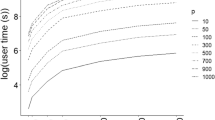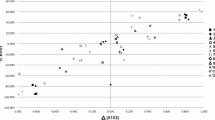Abstract
So far, during classification, we have been interested in finding a model that decides if an instance belongs to a class or not; the model’s answer would be a yes or no with certainty. The situation with Bayesian modeling for decision-making is different—it estimates the probability that an instance belongs to a certain class, which is more nuanced [1].
Access this chapter
Tax calculation will be finalised at checkout
Purchases are for personal use only
Similar content being viewed by others
References
P.D. Hoff, A First Course in Bayesian Statistical Methods (Springer, New York, 2009)
M. Gopal, Applied Machine Learning (McGraw-Hill Education, 2018)
D.D. Lewis, Naive (Bayes) at forty: The independence assumption in information retrieval, in Machine Learning: ECML-98, ed. by C. Nédellec, C. Rouveirol, (Springer, Berlin, Heidelberg, 1998), pp. 4–15
I. Kononenko, Semi-naive bayesian classifier, in Machine Learning — EWSL-91, ed. by Y. Kodratoff, (Springer, Berlin, Heidelberg, 1991), pp. 206–219
P. Golpour et al., Comparison of support vector machine, Naïve Bayes and logistic regression for assessing the necessity for coronary angiography. Int. J. Environ Res. Public Health 17(18), 6449 (4 Sep 2020). https://doi.org/10.3390/ijerph17186449
D. Harada, H. Asanoi, T. Noto, J. Takagawa, Naive bayes prediction of the development of cardiac events in heart failure with preserved ejection fraction in an outpatient clinic - beyond B-type natriuretic peptide. Circ. J. 86(1), 37–46 (30 Jul 2021). https://doi.org/10.1253/circj.CJ-21-0131
N.A. Mansour, A.I. Saleh, M. Badawy, H.A. Ali, Accurate detection of Covid-19 patients based on Feature Correlated Naïve Bayes (FCNB) classification strategy. J. Ambient Intell. Humaniz. Comput. 13(1), 41–73 (15 Jan 2021). https://doi.org/10.1007/s12652-020-02883-2
L. Yang et al., Prediction model of the response to neoadjuvant chemotherapy in breast cancers by a naive Bayes algorithm. Comput. Methods Prog. Biomed. 192, 105458 (Aug 2020). https://doi.org/10.1016/j.cmpb.2020.105458
H. Zhang et al., Develo** novel computational prediction models for assessing chemical-induced neurotoxicity using naïve Bayes classifier technique. Food Chem. Toxicol. 143, 111513 (Sep 2020). https://doi.org/10.1016/j.fct.2020.111513
E. Crawford, J. Kay, E. McCreath, IEMS - the intelligent email sorter, in Presented at the Proceedings of the Nineteenth International Conference on Machine Learning (2002)
R. J. Mooney, L. Roy, Content-based book recommending using learning for text categorization. Presented at the Proceedings of the fifth ACM conference on Digital libraries, San Antonio, Texas, USA, (2000). [Online]. Available: https://doi.org/10.1145/336597.336662
T. Trappenberg, Fundamentals of Machine Learning (OUP, Oxford, 2019)
R.R. Bouckaert, Naive Bayes classifiers that perform well with continuous variables, in AI 2004: Advances in Artificial Intelligence, ed. by G. I. Webb, X. Yu, (Springer, Berlin, Heidelberg, 2005), pp. 1089–1094
C. N. Hsu, H. J. Huang, T. T. Wong, Why discretization works for Naïve Bayesian classiers, in 17th International Conference on Machine Learning (ICML-2000), (2000)
Y. Yang, G.I. Webb, On why discretization works for naive-bayes classifiers, in AI 2003: Advances in Artificial Intelligence, ed. by T. D. Gedeon, L. C. C. Fung, (Springer, Berlin, Heidelberg, 2003), pp. 440–452
G. H. John, P. Langley, Estimating continuous distributions in BAYESIAN classifiers. Presented at the Proceedings of the Eleventh Conference on Uncertainty in Artificial Intelligence, Montréal, Qué, Canada, (1995)
J. Brownlee, Master Machine Learning Algorithms: Discover How They Work and Implement them from Scratch (Jason Brownlee, 2016)
P. Domingos, M. Pazzani, On the Optimality of the Simple Bayesian Classifier Under Zero-One Loss. Mach. Learn. 29(2), 103–130 (1 Nov 1997). https://doi.org/10.1023/A:1007413511361
Author information
Authors and Affiliations
Rights and permissions
Copyright information
© 2022 The Author(s), under exclusive license to Springer Nature Switzerland AG
About this chapter
Cite this chapter
El Morr, C., Jammal, M., Ali-Hassan, H., El-Hallak, W. (2022). Naïve Bayes. In: Machine Learning for Practical Decision Making. International Series in Operations Research & Management Science, vol 334. Springer, Cham. https://doi.org/10.1007/978-3-031-16990-8_9
Download citation
DOI: https://doi.org/10.1007/978-3-031-16990-8_9
Published:
Publisher Name: Springer, Cham
Print ISBN: 978-3-031-16989-2
Online ISBN: 978-3-031-16990-8
eBook Packages: Mathematics and StatisticsMathematics and Statistics (R0)




